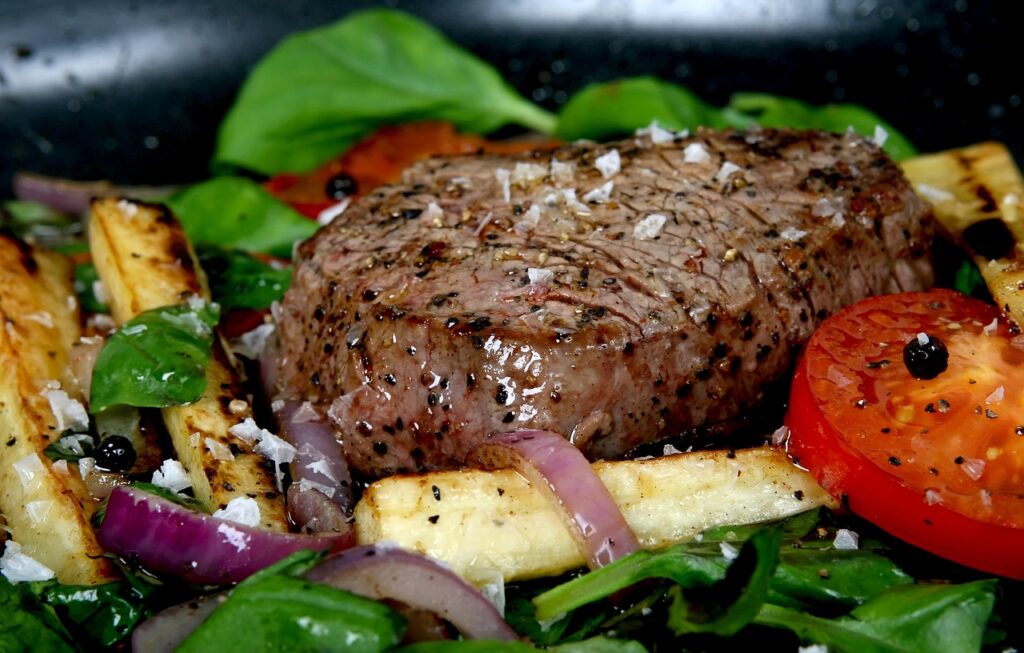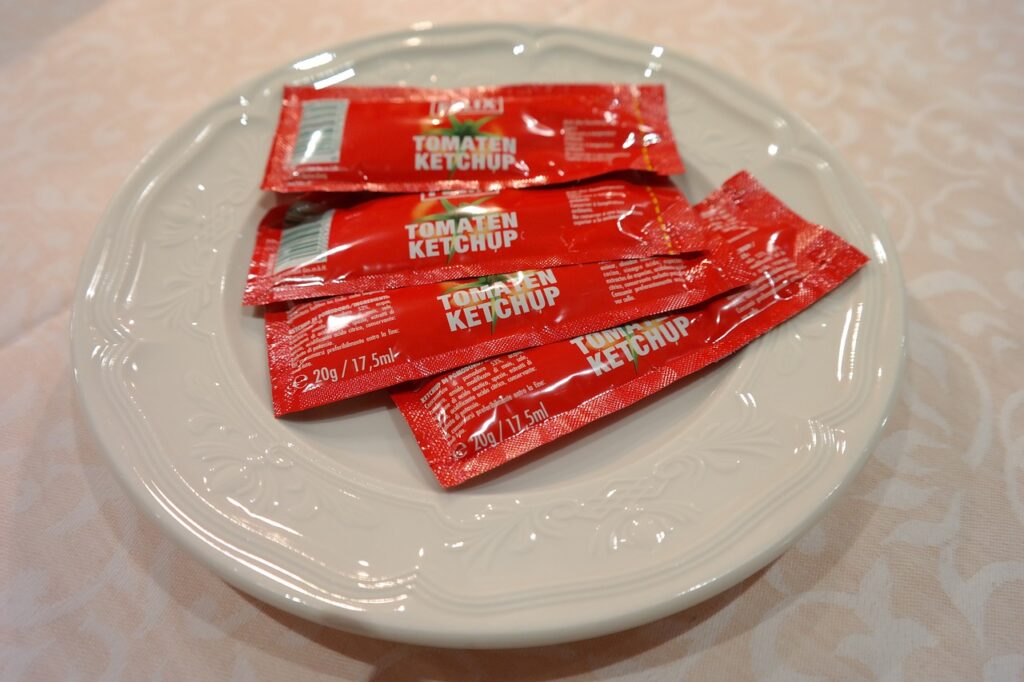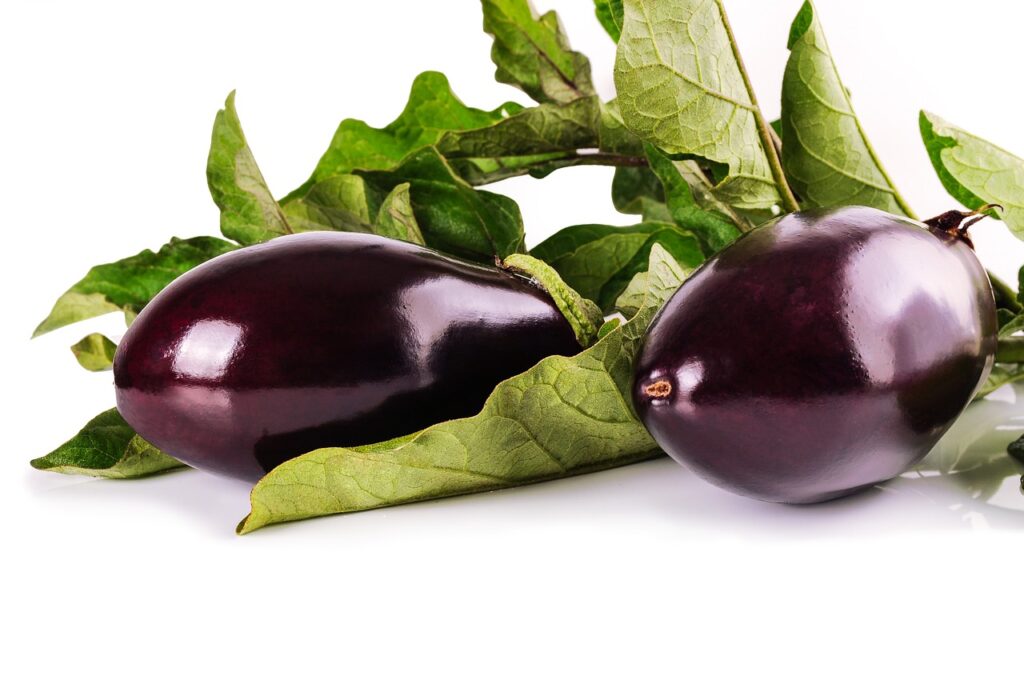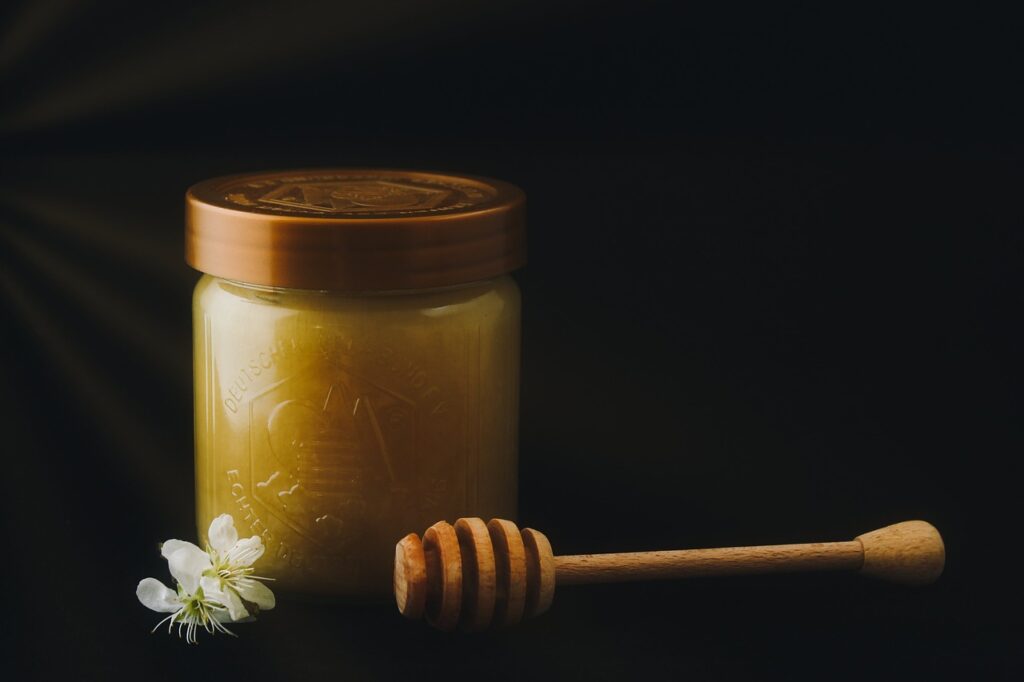Finding the perfect low-carb pasta replacement is like searching for a needle in a haystack. With so many options out there, it can be overwhelming to know which ones are worth your time and taste buds.
But fear not, because in this discussion, you'll uncover the best low-carb pasta alternatives that will satisfy your cravings without sacrificing flavor.
So get ready to embark on a culinary journey that will revolutionize your pasta game, leaving you wanting more.
Zoodles
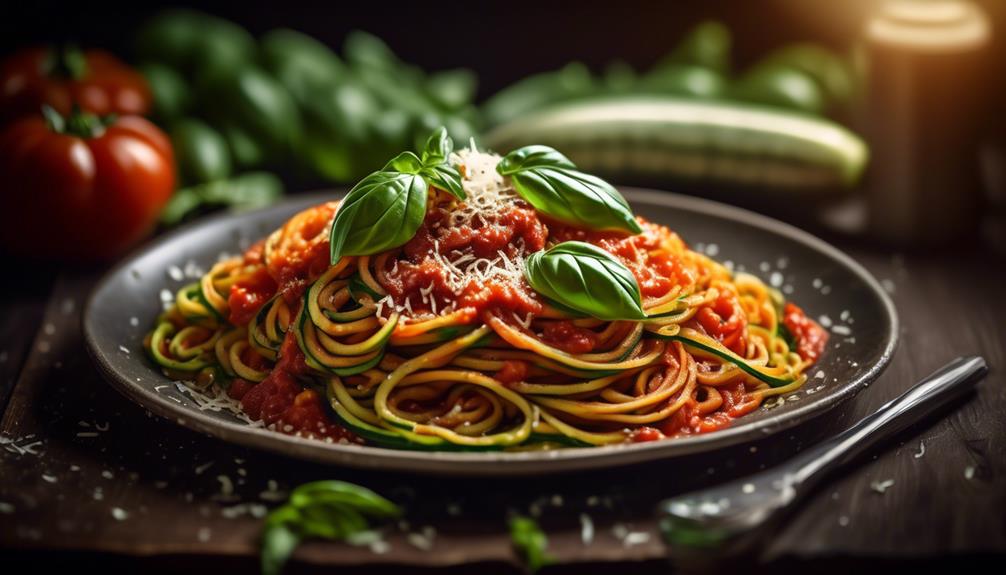
To incorporate a low-carb alternative into your pasta dishes, consider using zoodles, which are spiralized zucchini noodles. Zoodles have gained popularity as a healthy substitute for traditional pasta, especially for those following a low-carb or gluten-free diet. They offer a great way to enjoy your favorite pasta dishes while reducing your carbohydrate intake.
Zucchini noodles are easy to make and can be prepared using a spiralizer or a julienne peeler. They have a similar texture to pasta and can be used in various recipes, such as stir-fries, salads, and even as a base for sauces. Zoodles aren't only low in carbs but are also packed with nutrients. Zucchini is a good source of vitamins A and C, potassium, and fiber, making it a healthier option compared to regular pasta.
In addition to being low in carbs and nutrient-rich, zucchini noodles are also low in calories. A cup of zoodles contains only about 20-30 calories, compared to the 200-300 calories in a cup of cooked spaghetti. This makes zucchini noodles a great choice for weight management and overall health.
Shirataki Noodles
Shirataki noodles are a low-carb pasta replacement that offer several nutritional benefits. These noodles are made from konjac flour, which is high in fiber and low in calories, making them a great option for those following a low-carb or calorie-restricted diet.
Additionally, shirataki noodles are gluten-free and have a low glycemic index, making them suitable for individuals with dietary restrictions or diabetes.
Nutritional Benefits
With their low calorie and carbohydrate content, Shirataki noodles offer a nutritious alternative to traditional pasta. These noodles are made from the konjac plant, which is rich in dietary fiber and contains zero net carbs. Here are some nutritional benefits of Shirataki noodles:
- Low in calories: Shirataki noodles are extremely low in calories, making them a great option for those looking to reduce their calorie intake.
- High in fiber: These noodles are packed with soluble fiber, which can help regulate blood sugar levels and improve digestion.
- Gluten-free: Shirataki noodles are naturally gluten-free, making them an excellent choice for individuals with gluten sensitivities or celiac disease.
When it comes to cooking techniques, Shirataki noodles are typically rinsed and then boiled or stir-fried to remove any odor and improve their texture.
Incorporating Shirataki noodles into your diet can have various health implications, including weight loss, improved gut health, and better blood sugar control.
Cooking Tips
Enhance your Shirataki noodle cooking experience with these helpful tips.
When cooking Shirataki noodles, it's important to use the right cooking techniques to achieve the best results. Start by rinsing the noodles thoroughly to remove any unpleasant odor.
Next, boil the noodles for a few minutes to improve their texture.
To enhance the flavor, you can stir-fry the noodles with your favorite sauces and spices.
Remember to practice portion control when cooking with Shirataki noodles, as they're low in calories and carbohydrates. Use them as a base for your favorite pasta dishes, but be mindful of the amount you consume.
Cauliflower Rice
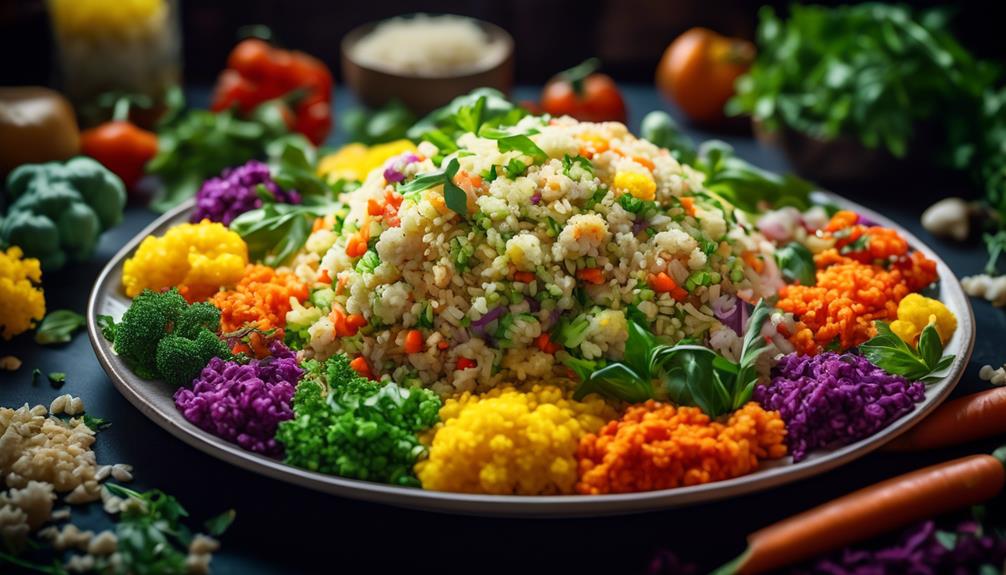
Cauliflower rice isn't only a low-carb alternative to traditional rice, but it also offers numerous nutritional benefits.
It's rich in fiber, vitamins, and minerals, while being low in calories and carbohydrates.
Additionally, it's versatile and can be cooked in various ways, such as sautéing, steaming, or even baking, making it a great option for those looking to reduce their carb intake.
Nutritional Benefits
To boost your nutritional intake, consider incorporating cauliflower rice into your low-carb pasta replacements. Cauliflower rice is a versatile and nutritious option that can provide several health benefits.
Here are three ways to incorporate cauliflower rice into your diet:
- As a base: Replace traditional pasta or rice with cauliflower rice as a base for your favorite dishes like stir-fries or curries. This swap is an easy way to reduce your carb intake while still enjoying a satisfying meal.
- In salads: Add cauliflower rice to your salads for extra texture and nutrients. It provides a low-calorie alternative to traditional grains and adds a subtle, nutty flavor to your salad.
- In soups and stews: Mix cauliflower rice into soups and stews for a heartier texture. It absorbs the flavors of the broth and adds bulk without adding excessive carbohydrates.
While low-carb pasta replacements have their benefits, it's important to note that they may not suit everyone. Some potential drawbacks include a different taste and texture compared to traditional pasta and a higher price point. Nonetheless, incorporating cauliflower rice into your low-carb pasta replacements can contribute to a well-rounded and nutritious diet.
Cooking Methods
One popular cooking method for cauliflower rice is to sauté it in a pan with olive oil and seasonings. Sautéing is a quick and easy cooking technique that helps to bring out the natural flavors of cauliflower rice.
To prepare it this way, simply heat a pan over medium heat, add some olive oil, and then toss in the cauliflower rice along with your choice of seasonings, such as garlic, onion, or herbs. Cook for about 5-7 minutes, stirring occasionally, until the cauliflower rice is tender and lightly browned.
This cooking method not only adds flavor to the cauliflower rice but also helps to retain its texture. Incorporating sautéed cauliflower rice into your meal planning can be a delicious and low-carb alternative to traditional pasta.
Creative Recipe Ideas
To expand your culinary repertoire with cauliflower rice, try incorporating it into a variety of creative and low-carb recipes. Cauliflower rice is a versatile ingredient that can be used as a substitute for traditional rice or pasta, allowing you to enjoy your favorite dishes while reducing your carbohydrate intake.
Here are some recipe ideas that showcase the versatility of cauliflower rice:
- Cauliflower Fried Rice: Sauté cauliflower rice with vegetables, protein of your choice, and soy sauce for a flavorful and healthy alternative to the classic takeout dish.
- Cauliflower Rice Pizza Crust: Mix cauliflower rice with egg, cheese, and spices, then bake it into a crispy crust. Top with your favorite pizza toppings for a low-carb pizza option.
- Cauliflower Rice Stuffed Peppers: Fill bell peppers with a mixture of cauliflower rice, ground meat or plant-based protein, and seasonings, then bake until tender. This is a delicious and nutritious twist on a classic dish.
With these recipe alternatives and creative flavor combinations, you can enjoy the benefits of cauliflower rice in a variety of delicious and satisfying ways.
Spaghetti Squash
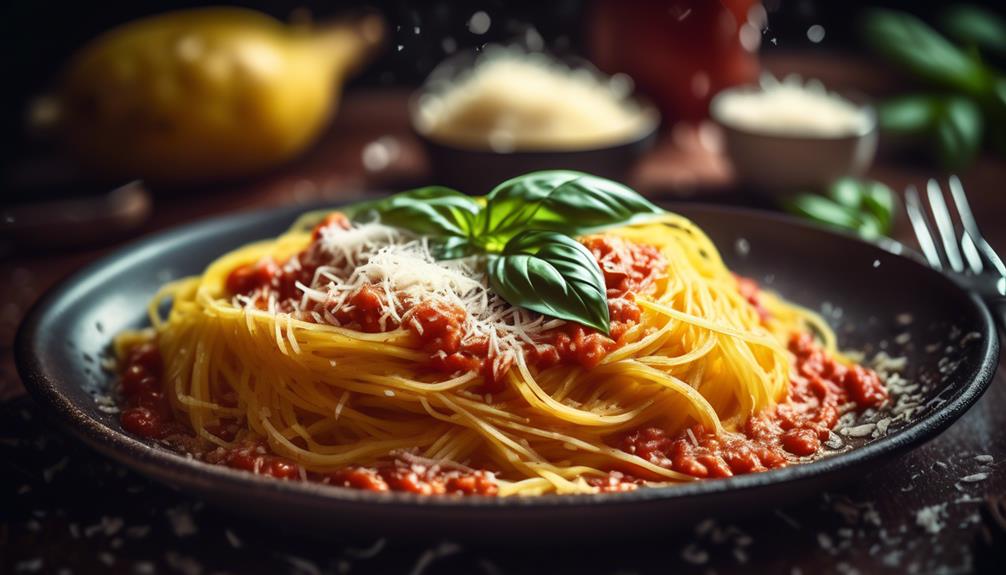
If you're looking for a low-carb alternative to traditional pasta, spaghetti squash is an excellent choice. Not only does it have a nutritional value that sets it apart from regular pasta, but it also offers a unique flavor profile that can enhance your dishes.
Spaghetti squash is a nutrient-dense vegetable that's low in calories and carbohydrates. It's packed with vitamins A and C, as well as minerals like potassium and manganese. This makes it a great option for those looking to reduce their carbohydrate intake while still getting essential nutrients.
In terms of flavor, spaghetti squash has a mild and slightly sweet taste. It has a subtle squash flavor that pairs well with a variety of sauces and toppings. When cooked properly, the flesh of the squash can be scraped into long strands that resemble spaghetti noodles, hence the name. This makes it a versatile ingredient that can be used in place of traditional pasta in a wide range of recipes.
Whether you're following a low-carb diet or simply looking to incorporate more vegetables into your meals, spaghetti squash is a fantastic option. Its nutritional value and unique flavor profile make it a satisfying and healthy alternative to regular pasta.
Eggplant Noodles
For a delicious and low-carb pasta replacement, consider trying eggplant noodles.
Eggplant is a versatile vegetable that can be transformed into satisfying pasta-like strands. Here are some reasons why eggplant noodles are a great alternative:
- Nutrient-rich: Eggplants are packed with vitamins, minerals, and antioxidants, making them a healthy choice for your pasta dishes.
- Low in carbs: Eggplants are naturally low in carbohydrates, making them suitable for those following a low-carb or keto diet.
- Versatile and flavorful: Eggplant noodles can be used in a variety of dishes, such as eggplant lasagna or eggplant Parmesan, adding a rich and savory flavor to your meals.
When making eggplant noodles, you can either slice the eggplant into thin strips or use a spiralizer to create spaghetti-like strands. To enhance the flavor, you can roast or sauté the noodles before incorporating them into your favorite pasta recipe.
Eggplant noodles also pair well with tomato-based sauces, cheese, and herbs, adding a delightful twist to traditional pasta dishes.
Kelp Noodles
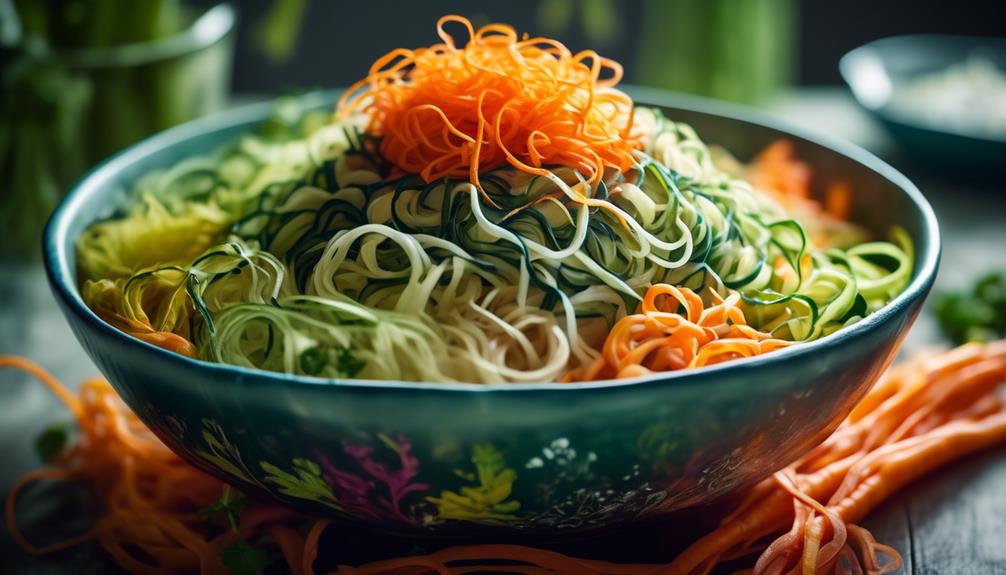
Kelp noodles provide a nutritious and low-carb alternative to traditional pasta dishes. These translucent noodles are made from kelp, a type of seaweed, and are packed with essential vitamins and minerals. Kelp noodles are rich in iodine, which is vital for thyroid function and metabolism. They also contain calcium, iron, and magnesium, which contribute to bone health and energy production.
When it comes to taste, kelp noodles have a mild and slightly salty flavor. Their texture is crunchy and firm, making them a great addition to salads and stir-fries. However, it's important to note that kelp noodles don't have the same taste and texture as traditional wheat or grain-based pasta.
In terms of nutritional value, kelp noodles are low in calories and carbohydrates. They're also gluten-free and suitable for those following a gluten-free or paleo diet. Compared to regular pasta, kelp noodles have fewer calories and carbs, making them a suitable option for weight management and blood sugar control.
If you're looking for a low-carb pasta replacement that provides nutritional value and a unique taste, kelp noodles are definitely worth a try.
Cabbage Noodles
Continuing our exploration of low-carb pasta replacements, let's now turn our attention to cabbage noodles. Cabbage is a versatile and nutritious vegetable that can be transformed into a pasta-like substitute, making it an excellent choice for those following a low-carb diet. Here are some reasons why cabbage noodles are worth a try:
- Low in carbohydrates: Cabbage is naturally low in carbs, making it a suitable option for those looking to reduce their carb intake. With just 5 grams of carbs per cup, cabbage noodles can be enjoyed without worrying about spiking blood sugar levels.
- High in fiber: Cabbage is packed with fiber, which aids in digestion and promotes feelings of fullness. This can be beneficial for weight management and overall gut health.
- Easy to prepare: Making cabbage noodles is a breeze. Simply slice the cabbage into thin strips or use a spiralizer to create noodle-like shapes. They can then be sautéed, steamed, or even enjoyed raw in salads.
Incorporating cabbage noodles into your meals can be a great way to add variety to your low-carb diet. From stir-fries to soups, there are countless cabbage pasta recipes available that cater to different tastes and preferences. Give cabbage noodles a try and discover a delicious, low-carb alternative to traditional pasta.
Bean Sprout Noodles
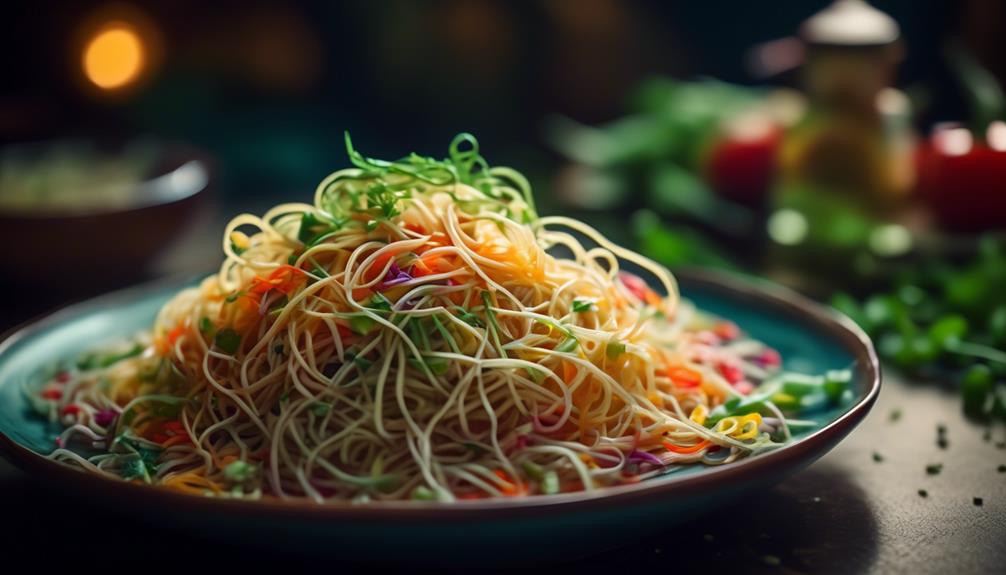
To add another low-carb pasta alternative to your repertoire, consider trying bean sprout noodles. Bean sprout pasta is a nutritious and delicious option that can satisfy your pasta cravings while keeping your carb intake low. Made from bean sprouts, these noodles are low in carbohydrates and calories, making them a popular choice for those following a low-carb or ketogenic diet.
One of the key benefits of bean sprout noodles is their low carbohydrate content. Unlike traditional pasta made from wheat or grains, bean sprout noodles contain significantly fewer carbs. This makes them an excellent choice for individuals looking to reduce their carb intake or manage their blood sugar levels.
In addition to being low in carbs, bean sprout pasta is also packed with essential nutrients. They're a good source of dietary fiber, which can aid in digestion and promote satiety. Bean sprouts are also rich in vitamins and minerals, including vitamin C, vitamin K, and potassium.
When it comes to preparing bean sprout noodles, they're incredibly versatile. You can use them as a substitute for traditional pasta in a variety of dishes, such as stir-fries, soups, and salads. They've a mild flavor that pairs well with different sauces and seasonings, allowing you to create a wide range of delicious low-carb meals.
Spiralized Carrots
To expand your repertoire of low-carb pasta alternatives even further, consider incorporating spiralized carrots. Carrot pasta, also known as carrot noodles, can be a delicious and nutritious substitute for traditional pasta. Here are three reasons why you should give spiralized carrots a try:
Versatility:
Spiralized carrots can be used in a variety of dishes, making them a versatile option for your meals. You can use them as a base for stir-fries, salads, or even as a topping for soups. The mild flavor of carrots allows them to complement a wide range of ingredients and sauces.
Nutritional benefits:
Carrots are packed with vitamins, minerals, and antioxidants. They're a great source of vitamin A, which is important for maintaining healthy vision and promoting immune function. Carrots are also low in calories and high in fiber, making them a filling and satisfying addition to any meal.
Easy to prepare:
Creating carrot noodles is a simple and quick process. All you need is a spiralizer or a julienne peeler to transform carrots into pasta-like strands. You can enjoy them raw for a crunchy texture or lightly sauté them for a softer consistency. There are countless carrot noodle recipes available online, offering endless possibilities for your culinary creations.
Incorporating spiralized carrots into your low-carb diet can add variety and nutrition to your meals. Give carrot pasta a try and discover new flavors and textures while keeping your carbohydrate intake in check.
Conclusion
In conclusion, there are several delicious and nutritious low-carb pasta replacements available.
One interesting statistic to note is that zoodles, which are spiralized zucchini noodles, contain only 3 grams of carbs per cup, compared to traditional pasta that can have up to 40 grams of carbs per cup.
This makes zoodles a great option for those looking to reduce their carbohydrate intake while still enjoying a pasta-like dish.


